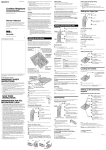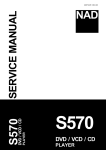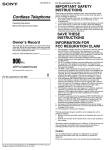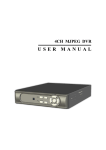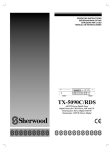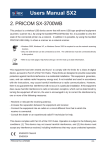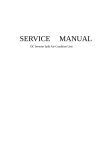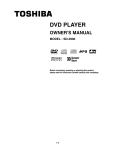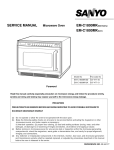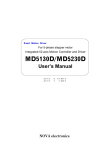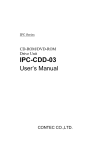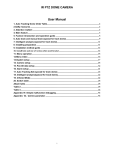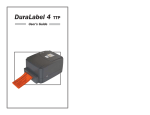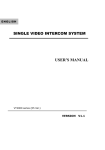Download SERVICE MANUAL Microwave Oven EMO-SRT1(NX) EMO
Transcript
FILE NO. SERVICE MANUAL Microwave Oven EMO-SRT1(NX) EMO-SRT1(SG) Model No Pro.Code No EMO-SRT1NX 437 517 01 EMO-SRT1SG 437 517 00 Foreword Read this manual carefully, especially precaution on microwave energy, and follow the procedure strictly, careless servicing and testing may expose yourself to the microwave energy leakage. PRECAUTIONS PRECAUTIONS TO BE OBSERVED BEFORE AND DURING SERVICING TO AVOID POSSIBLE EXPOSURE TO EXCESSIVE MICROWAVE ENERGY (a) Do not operate or allow the oven to be operated with the door open. (b) Make the following safety checks on all ovens to be serviced before activating the magnetron or other microwave source, and make repairs as necessary: (1)Interlock operation, (2) proper door closing, (3) seal and sealing surfaces (arcing, wear, and other damage), (4) damage to or loosening of hinges and latches, (5) evidence of dropping or abuse. (c) Before turning on microwave power for any service test or inspection within the microwave generating compartments, check the magnetron, wave guide or transmission line, and cavity for proper alignment, integrity, and connections. (d) Any defective or misadjusted components in the interlock, monitor, door seal, and microwave generation and transmission systems shall be repaired replaced, or adjusted by procedures described in this manual before the oven is released to the owner. REFERENCE NO. SM-6410005-00 - TABLE OF CONTENTS Adjustment Procedures ............................................. 1 Specifications ............................................................ 2 Power output Measurement ...................................... 2 Precautions and Repair Service Tips ....................... 2 Circuit Diagram ......................................................... 3 Test Procedures and Troubleshooting............... 4-10 Disassembly Instructions ............................ 11-14 Exploded View and Parts List ............................ 15-22 Overall Circuit Diagram................................. 23-25 up and rotated counterclockwise until there is zero gap between the latch lever and the switch bodies when the door latch is securely locked. (4) Make sure the latch interlock switch open before the interlock monitor switches coses when the door is opened very slowly, according to “CHECKOUT PROCEDURE FOR SWITCHES” on page 6. (5)Make sure the microwave energy leakage is below the limit of the reguration 5 mW/cm 2when measured with a detector. (All service adjustments must be made for minimum microwave energy leakage readings.) NOTE: If the interlock monitor circuit operates and at the same time the fuse blows with the door open, be sure to replace the relay circuit board , Interlock switch and monitor switch. CAUTION MICROWAVE RADIATION PERSONNEL SHOULD NOT BE EXPOSED TO THE MICROWAVE ENERGY WHICH MAY RADIATE FROM THE MAGNETRON OR OTHER MICROWAVE GENERATING DEVICE IF IT IS IMPROPERLY USED OR CONNECTED. ALL INPUT AND OUTPUT MICROWAVE CONNECTIONS, WAVEGUIDE, FLANGES, AND GASKETS MUST BE SECURE. NEVER OPERATE THE DEVICE WITHOUT A MICROWAVE ENERGY ABSORBING LOARD ATTACHED. NEVER LOOK AN OPEN WAVEGUIDE OR ANTENNA WHIL THE DEVICE IS ENERGIZED. 1. ADJUSTMENT PROCEDURES TO AVOID POSSIBLE EXPOSURE TO MICROWAVE ENERGY LEAKAGE, THE FOLLOWING ADJUSTMENTS OF THE INTERLOCK SWITCHES SHOULD BE MADE ONLY BY AUTHORIZED SERVICE PERSONNEL. Lever Stopper A.INTERLOCK SWITCH AND DOOR SENSING SWITCH ADJUSTMENT(Figure 1) (1) Loosen 2 screws securing the lever stopper. (2) Adjust the lever stopper position so that it is pushed up and rotated counterclockwise until there is zero gap between the latch and the switch bodies when the door latch is securely locked. (3) Tighten the lever stopper screws securely. (4) Make sure the latch interlock switch and the door sensing switch open before the interlock monitor switches coses when the door is opened very slowly, according to “CHECKOUT PROCEDURE FOR SWITCHES” on page 7. (5)Make sure the microwave energy leakage is below the limit of the reguration5 mW/cm 2when measured with a detector. (All service adjustments must be made for minimum microwave energy leakage readings.) Interlock monitor switch Lever Door sensing switch Door Interlock switch Screws B.DOOR INTERLOCK SWITCHES ADJUSTMENT (Figure 1) (1) Loosen 2 screws securing the lever stopper. (2) Adjust the lever stopper position so that it is pushed Figure 1 - 1 - 2.SPECIFICATIONS A. SINCE NEARLY 4,000 VOLTS EXISTS IN SOME CIRCUITS OF THIS MICROWAVE OVEN, REPAIRS SHOULD BE CARRIED OUT WITH GREAT CARE. B. TO AVOID POSSIBLE EXPOSURE TO MICROWAVE ENERGY LEAKAGE, THE FOLLOWING PRECATIONS MUST BE TAKEN BEFORE SERVICING. (1) Before the power is applied. (a) Open and close door several times to make sure the interlock switch, door sensing switch and interlock monitor switch operate properly. (Listen for the clicking sound from switches.) Make sure the interlock monitor switch is closed after the interlock switch and door sensing are open when the door is opened. (See pages 1 and 7) (b) Make sure the perforated screen and the choke dielectric of the door are correctly mounted. (2) After the power is applied. (a) Open and close the door to see if the interlock mechanism operates properly. (b) Check microwave energy leakage with a leakage detector and confirm the energy leakage is below 5mW/cm2 (3) Do not operate the unit until it is completely repaired of any of the following conditions. (a) Door is not closed firmly against the cavity front. (b) The hinge is broken. (c) The choke dielectric or the door seal is damaged. (d) The door is bent or warped, or there is any other visible damage to the oven that may cause microwave energy leakage. Note: Always keep the seal clean. (e) Make sure that there are no defective parts in the interlock mechanism. (f) Make sure that there are no defective parts in the microwave generating and transmission assembly. (especially wave guide). (4) The following items should be checked after the unit is repaired. (a) The interlock monitor switch is connected correctly and firmly. (b) The magnetron gasket on the magnetron is properly positioned. (c) Waveguide and oven cavity are intact. (No leakage of microwave energy). (d) The door can be properly closed and the safety switches work properly. (e) The oven must be stopped when the door is opened or the time is up. The oven must not be operated with any of the above components removed or by passed. Microwave output ................ 700W Frequency ........................... 2,450MHz Power supply ....................... 220-230V, 50Hz Rated current Microwave..5.0 Amp. Heater........5.7 Amp. Safety Device ...................... Thermal protector(Magnetron) 135°C Open Thermistor (Oven) Fuse (Cartridge Type) ................. 250V 8 A Micro switch, Safty Relay Door Interlock Switch Interlock monitor Switch Door sensing Switch and SaftyRelay Max. input time .................... Electronic Digital, up to Reheat/Oven 30min. More/Less 120min. Overall Dimensions ........ 510(W)x458(D)x345(H) mm Oven cavity size ............ 352(W)x352(D)x235(H) mm Effective Capacity of Oven Cavity.........25.1liters Net weight ........................... 20Kg 3. POWER OUTPUT MEASUREMENT (1) Prepare 1000±5cc tap water. (2) Adjust water temperature to 10 ±2°C. (3) Pour the water into a container made of borosilicate glass, 190mm outer diameter cylinder, maximum 3 mm thickness. NOTE: Use the container kept on the room temperature. (4)Place the container in the center of the oven cavity. (5) Set the heating time for 60 seconds and rating full power and then start oven. (6) Take container out immediately when heating time up. (7) Stir water for making even water temperature in the container. (8) Measure the water temperature. Water temperature rise shall be 8°C to 12°C. (9) For correct Power output measurement, the line voltage under load must be 230±2Volts. 4.PRECATIONS AND REPAIR SERVICE TIPS PRELIMINARY - 2 - 5.CIRCUIT DIAGRAM Timer S301 Thermistor Magnetron Detector (Infrared sensor) S101 S201 S103 Shatter motor H.VDiode S104 H.V Capacitor Fuse Diode S102 S12 Door Sensing SW H.V Transforemer S12 RL-4 Geared motor RL-6 Lower Heater Upper Heater White RL-5 Main Relay Black Monitor SW S11 RL-3 Lamp Main circuit side RL-8 Blower motor White Thermal limiter Door Interlock SW White Noise filter AC 230-240V 50Hz Black Figure 3 * Caution: The voltage between filament leads of magnetron is about 3.3VA.C, but the filament carries 4KV/DC high voltage with respect to ground.Never touch these leads with bare hand during operation. - 3 - 6. TEST PROCEDURES AND TROUBLESHOOTING PRIMARY CAUTION WINDINGS -DISCONNECT THE POWER SUPPLY CORD FROM THE WALL OUTLET WHENEVER REMOVING THE CABINET FROM THE UNIT. PROCEED WITH TESTS ONLY AFTER DISCHARGING THE HIGH VOLTAGE CAPACITORS AND REMOVING THE LEAD WIRES ON THE PRIMARY WINDING OF THE HIGH VOLTAGE TRANSFORMERS FOR LOWER AND UPPER MAGNETRONS. Filament Windings (SEE FIGURE 3) A. TEST PROCEDURES COMPONENT MAGNETRON Secondary Windings Figure 3 CHECKOUT PROCEDURE RESULT 1) Check for resistance: Across the filament terminal of the magnetron with an ohm - meter on Rx1 scale. Normal reading: Less than 1 ohm. Figure 4 2) Check for resistance: Between each filament terminal of the magnetron and the chassis ground with an ohm-meter on highest scale. Normal reading: Infinite ohms. Figure 5 HIGH-VOLTAGE TRANSFORMER 1) Measure the resistance: With an ohm-meter on R x1 scale. a. Primary winding; b. Filament winding; c. Secondary winding; 2) Measure the resistance: with an ohm-meter on highest scale. a. Primary winding to ground; b. Filament winding to ground; Figure 6 - 4 - Normal reading: Approximately 2.0 ohms Less than 1 ohm. Approximately 137 ohms Normal reading: Infinite ohms. Infinite ohms. Note: Remove varnish of measured point. COMPONENT HIGH-VOLTAGE CAPACITOR Including internal bleeder resistor CHECKOUT PROCEDURE RESULT Measure the resistance: Across two terminals with an ohm-meter on highest scale. Normal reading: Momentarily indicates several ohms, and gradually to 10 meg-ohms. Abnormal reading: Indicates continuity or 10 meg-ohms from the beginning. Figure 7 HIGH-VOLTAGE DIODE Measure the resistance: Across two terminals with an ohm-meter on highest scale. Figure 8 Measure the resistance: Across two terminals with an ohm-meter on highest scale. Normal reading: Indicate about middle position in one direction (forward) and infinite ohms in the reverse direction, using ohm meter with a 9V battery. NOTE - Some digital meter may show more than 0 ohms or infinite ohms even in a forward direction because the low measuring voltage of the meter does not allow the meter to pass through the high voltage diode. Use an ohm meter with a 9V battery. Abnormal reading: Indicates continuity or infinite ohms in both directions. Normal reading: Indicate infinite ohms in both directions. FUSE DIODE Figure 9 - 5 - Abnormal reading: Indicates continuity in both directions or continuity in one direction and infinite ohms in reversed direction. THERMISTOR CHART Duct Magnetron Thermistor connector 7. DISASSEMBLY INSTRUCTIONS - THE OVEN MUST BE DISCONNECTED FROM THE ELECTRICAL OUTLET WHEN MAKING REPLACEMENTS, REPAIRS, ADJUSTMENT OR CONTINUITY CHECKS. BEFORE PROCEEDING WITH ANY REPAIR, WORK , WAIT AT LEAST 1 MINUTE, UNTIL THE CAPACITOR IN THE HIGH VOLTAGE AREA HAS FULLY DISCHARGED. B.REMOVING DOOR INTERLOCK SWITCH (See Figure on page 1) (1) Disconnect all lead wires from the door interlock switch . (2) Remove 2 screw secutring the lever stopper. (3) Pull out the door interlock switch toward you while pressing switch stopper. (4) Make the necessary adjustments or replacement of the switch by reversing step (3) and check microwave energy leakage according to “1. ADJUSTMENT PROCEDURE FOR SWITCHES” on page 1. Check proper operation according to “CHECKOUT PROCEDURE FOR SWITCHES” on page 7. A. REMOVING INTERLOCK MONITOR SWITCH (See Figure 1 on page 1) (1) Disconnect all lead wires from the interlock monitor switches. (2)Remove 2 screw securing the lever stopper. (3)Pull out the interlock monitor toward you while pressing switch stopper. (4) Make the necessary adjustment, and perform a microwave energy leakage check according to “1. ADJUSTMENT PROCEDURE FOR SWITCHES” on page 1. Check proper operation according to “CHECKOUT PROCEDURE FOR SWITCHES” on page 7. - 10 - (6) Lift up the control circuit board from its left side and take out from the control base. C.REMOVING DOOR SENSING SWITCH (See Figure on page 1) (1) Disconnect all lead wires from the door sensing switch and door interlock switch. (2) Remove 2 screw securing the lever stopper. (3) Pull out the door sensing switch toward you while pressing switch stopper together with door interlock switch. (4) Make the necessary adjustments or replacement of the switch by reversing step (3) and check microwave energy leakage according to “1. ADJUSTMENT PROCEDURE FOR SWITCHES” on page 1. Check proper operation according to “CHECKOUT PROCEDURE FOR SWITCHES” on page 7. PCB for Power Bracket WHEN REPLACING ANY DOOR MICROSWITCH, REPLACE ONLY WITH THE SAME SWITCH SPECIFIED ON THE PARTS LIST. Figure 11 F.REMOVING TOUCH KEY BOARD (1) Remove the FPC connector from the connector S101 while pushing up the end of the plastic fastner. (2) Remove the control plate which is held on the control base with the adhesive tape from the front of control base. D. REMOVING FUSE Remove the 8 A fuse with screwdriver. NOTES - When replacing the 8 A fuse, be sure to use the exact repair part. - If the 8 A fuse blows immediately, check the primary and secondary interlock switch, the relays RL-4 and RL-1 (on the control circuit board) and the interlock monitor switch according to “CHECKOUT PROCEDURE FOR SWITCHES” on page 7 .Make sure to check the microwave energy leakage according to “1. ADJUSTMENT PROCEDURE FOR SWITCHES” on page 1, when the primary and secondary interlock switches, the relay RL-4 and RL-1 or the interlock monitor switch is adjusted or replaced. G. REMOVING MAGNETRONS (See Figure 12) (1) Remove the Cabinet. (2) Remove all lead wires from magnetron and thermal limiter on duct. (3) Remove 2 screws securing the stay plate. (4) Remove 4 screw securing magnetrons to the waveguide. (5) Remove magneron fromthe wave guide VERY CAREFULLY. NOTES - When removing the magnetron, make sure that its dome does not hit any adjacent parts, or it may be damaged. - When replacing the magnetron, be sure to install the magnetron gasket in the correct position and be sure that the gasket is in good condition. - After replacing the magnetron, check the microwave energy leakage to ensure it is below the limit of 5mW/cm2. - If the interlock switch, the relay RL-4 and RL-1 or the interlock monitor switch operate properly, determine which of the following is defective : control circuit board, high voltage transformer, high voltage capacitor, high voltage diode or magnetron. E. REMOVING CONTROL CIRCUIT BOARD (1) Remove the cabinet(frame). (2) Remove 2 screws securing the P.C.B for Power with bracket to the cavity. (Figure 11) Then take out it. (3) To remove the Control Assembly, remove the all connector and lead wires from the Control circuit board. (4) Remove 3 screws securing the Control Assebmbly to the cavity. (5) Remove the FPC connector from the connector S101 while pushing up the end of the plastic fastner . (5) Remove 6 screws securing the control circuit board. - 11 - I.RELEASING TYPE CONNECTOR This oven is provided with locked type connectors. When you remove a connector, pull the connector while releasing the lock by pressing “A” point shown below. Do not pull the wire of the connector. Connector: S1, S2, S102, S104 (Figure 13) A A Figure 13 Figure 14 Pull connector case (Never pull the wire) Figure 12 H.REMOVING DOOR (1) Remove the cabinet(frame). (2) Remove 2 screws securing the P.C.B for Power with bracket to the cavity. (Figure 11) Then take out it. (3) Remove the both of spring hanging to the arm. Note; When reinstalling the spring, be carefull of direction of the tip of spring. (4) To remove the arms, push the on its under the door closing. (5) Remove the 2 screws securing roller assembly to detatch the both of hinge. NOTES - After replacing the door, be sure to check that the interlock switch, the door sensing switch and the interlock monitor swich operate normally. (See pages 1 and 7) - After replacing the door, check for microwave energy leakage with a leakage detector. Microwave energy leakage must be below the limit of 5mW/cm2. Figure 15 J.DETECTOR (INFRALED SENSOR) (1) When microwave operation is overheating, check for surface of filter on infrared sensor and mounting place of infrared sensor to the cavity. If the clouding the surface of filter on infrared sensor, clean up the surface of filter using soft cloth and secure the 2 screws infrared sensor to ther mounting place certainly as shown in figure 16. - 12 - Shatter Filter Hanging up Sensor Figure 16 Adjustment Method for Infrared sensor When Control PCB or Infrared sensor is changed, please carry the following ‘Initialization’ adjustment out for the Infrared sensor. Procedure 1. Prepare 250g ±5g tap water and ice 500g ±5g. 2. Pour water and ice into a plastic tray with minimum 195mm inner diameter cylinder, maximum 60mmm height. 3. Plug in power cord. 4. Open the door. “0” will apper in the display window. 5. Place the turn table base and turn table. 6. Place the Plastic tray in the centre of the turn table in the oven. 7. Push the “GRILL” key. “0” s will appear in the display window. 8. Push together with “MORE/LESS” and “POWER” key for 1 second and more. Buzzer will beep tone. 9. Press the “OVEN TEMP.” key once. Buzzer will beep tone and the “0”s changes to a “0” D. D will flasing. 10. Press the “MORE/LESS” key once. Buzzer will beep tone. Temperature of Ice with water will be corrected automatically while measure the ice with water. After 3 seconds, its corrcted water temperature will appear in the display window. 11. Press the “STOP/CLEAR” key once. Buzzer will beep tone and the “0” °C changes to a flashing “0”. 12. Press “STOP/CLEAR” key once. Buzzer will beep tone and the “0” will appear in the display window. Flashing D will disappear. 13. Take the plastic tray out from oven cavity. - 13 - 8. EXPLODED VIEW AND PARTS LIST Main body Parts Parts marked with this sign have special Characterstics important for microwave leakage. When replacing any of these parts use only Manufacturers specified parts. Parts marked with this sign are supplied with high voltage exceeding 250V - 16 - Main body Parts Parts marked with this sign have special Characterstics important for microwave leakage. When replacing any of these parts use only Manufacturers specified parts. Parts marked with this sign are supplied with high voltage exceeding 250V - 17 - Main body Parts Parts marked with this sign are supplied with high voltage exceeding 250V - 18 - Parts marked with this sign have special Characterstics important for microwave leakage. When replacing any of these parts use only Manufacturers specified parts. Main body Parts Key No Service parts No 1 617 228 6303 3 617 220 9593 4 617 202 1577 5 617 221 7895 6 617 227 6847 7 617 227 6854 8 617 154 4701 9 617 219 7418 11 617 206 6295 12 617 192 6743 13 617 192 6729 14 617 225 0748 15 617 219 7401 16 617 219 6954 17 617 220 6585 19 617 227 7097 20 617 229 7743 21 415 002 8907 22 617 115 3422 23 617 129 1001 24 617 229 7699 25 617 227 7042 26 617 187 2217 27 617 227 7059 28 617 227 7028 29 617 215 9133 30 617 160 0421 31 617 193 3024 32 617 227 4263 33 617 227 7165 34 617 227 7172 35 617 227 7134 36 617 218 0571 37 617 228 2084 38 617 228 8420 39 423 017 8003 40 617 205 5800 41 617 207 6836 42 617 205 5817 44 617 144 5435 45 617 219 6633 Description FRAME DUCT THERMISTOR ASS’Y HEAT INSU. HEATER ASS’Y UPPER HEATER ASS’Y LOWER SPECIAL SCREW HEAT INSU. SHAFT ASSY SPECIAL WASHER PARTS BASE GEAR MOTOR CAVITY COVER ANTENNA COMP. DETECTOR COMP. BLOWER COMP. CORD COMP. NX MAGNETRON 2M243H(A) LAMP THERMOSTAT CORD COMP. SG LEVER SPRING LEVER LEVER STOPPER MICRO SWITCH DOOR INTER MICRO SWITCH DOOR SENSING MICRO SWITCH MONITOR P.C.B COMP. POWER LEAD WIRE ASS’Y H.V DIODE LEAD WIRE ASS’Y FUSE DIOD TRANSFORMER CAPACITOR P.C.B COMP. NOIZE FILTER INSU. SHEET FUSE 250V 8A SPRING CLIP SPRING FOOT CUSHION ASS’Y FOOT - 19 - Spec. FR-P.P E-7000 FR-PET JAE IL SNYO 240V 20W METORO ßC VERTICAL SGT 135ß SUS304-WPB D0.7 V-15G-1C25-M OMRON YAMATAKE V-5230D-142 V-16G-3C25-M OMRON P-BOARD TABUCHI HAMSUNG 0.85/2200 N/F PCB SOC SWP-B D1.6 SWP-B D1.6 P.P Q’ty 1 1 1 1 1 1 1 1 1 1 1 1 1 1 1 1 1 1 1 1 1 1 2 1 1 1 1 1 1 1 1 1 1 1 1 1 1 1 1 2 1 Control Panel Parts Key No 1 2 3 4 5 6 7 8 9 10 11 12 Service parts No 617 227 4218 617 219 6299 617 227 6939 617 219 7180 617 220 2365 617 219 7296 617 219 7289 617 220 2372 617 219 7203 617 219 7258 617 220 2389 617 220 2396 Description P.C.B COMP. CONTROL P.C.B COMP. SWITCH CONTROL PLATE CONTROL PLATE CONTROL PLATE ORNAMENT PLATE ORNAMENT PLATE KNOB BODY CONTROL BASE SWITCH BUTTON SWITCH BUTTON FLAT CABLE Spec. C-BOARD SW-BOARD SUS430 HL#150 T0.4 PMMA SUS430 2BC T0.3 SUS430 2BC T0.3 PC+ABS(S1500V) PET+ABS ABS UL20706 L170 20PBNCD Q’ty 1 1 1 1 1 1 1 1 1 1 1 1 Parts marked with this sign have special Characterstics important for microwave leakage. When replacing any of these parts use only Manufacturers specified parts. -20- Door Parts Key No 1 2 3 4 5 6 7 9 10 11 12 13 Service parts No Description Spec. 617 219 6657 DOOR ASSY. COMP. 617 219 6787 DOOR ORNAMENT PLATE PC+ABS 617 229 6838 DOOR ORNAMENT PLATE SUS430 T0.3 617 219 6756 DOOR COVER 617 227 6724 DOOR PANEL 617 227 6731 CHOKE DIELECTRIC FR-PET 617 219 6763 DOOR HANDLE 617 102 7495 SPECIAL SCREW CAP TIGHT 617 222 0802 PACKING NITTO NO.686P 617 222 0819 PACKING NITTO NO.686P 617 229 0485 PACKING 617 230 6582 DOOR ORNAMENT PLATE -21- Q’ty 1 1 1 1 1 1 1 2 1 1 1 1 Packing Parts Key No 4 5 6 7 8 9 Service parts No 617 219 6251 617 219 6466 617 219 7630 617 219 7647 617 227 7233 617 216 0092 Description TURN TABLE BASE BAKING TRAY TURNTABLE COOKING RACK INST. MANUAL GLOVE - 22 - Spec. SWM-B ENGLISH Q’ty 1 1 1 1 1 1 9. OVERALL CIRCUIT DIAGRAM - 23 - - 24 - - 26 - Nov./99 Printed in JAPAN - 27 -
























